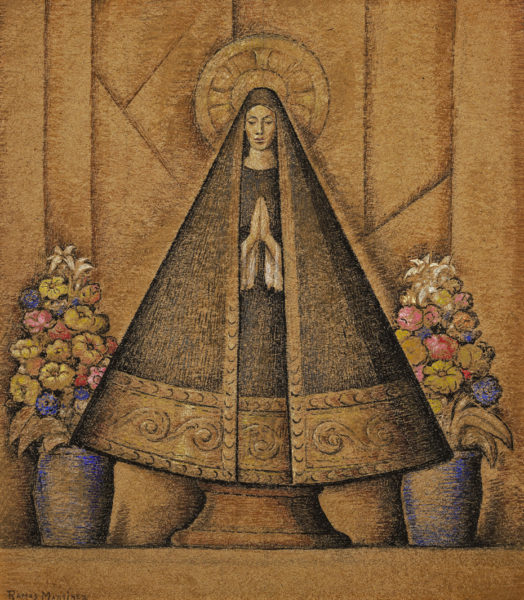
Alfredo Ramos Martinez, Madonna with Flowers (La Virgen de San Juan), n. d., Gouache, 26 5/8 in. x 23 5/16 in., Gift of Mrs. Doyle Hinton, Scripps College
A Prayer for a Dying Daughter
Though one might initially identify La Virgin de San Juan as a painting of the Virgin Mary, the work is actually a painting of a statue of the virgin. A modern example of a colonial genre of statue painting, the work depicts the Virgin at San Juan, a popular pilgrimage destination in Mexico. The tradition of statue painting is largely associated with Peru, though examples were produced at Hidalgo, Mexico. In the colonial era, priests would commission paintings of statues in their parish that had been said to have performed miracles. A depiction of a miraculous statue could then be transported to other locations to perform miracles of its own, both spreading the fame of the original statue and giving parishes far away a chance at experiencing the good will toward humanity that the original statue represented.
The story behind this work elicits the same emotional charge and reverence as colonial paintings; Alfredo Ramos Martinez needed a miracle. His daughter, Maria, was born with a congenital bone disease and required a warm climate, hence his move to California in the early 1930s, where he painted this statue. Though the exact date of this painting is unknown, the 1940s saw Ramos increasingly exploring images of the Virgin and Child in response to Maria’s worsening condition. This religiosity, along with nostalgia for Mexico, prompted this depiction of the Virgin at San Juan, based on a statue in Jalisco, Mexico.
The story of the Virgin at San Juan is apt for an artist sleepless over the health of his child. During the 17th century, the story goes, a trapeze artist set up a series of knives to leap over as part of his act. But before he could perform, his youngest daughter, a child of six, tripped and fell onto one of these knives. Though the injury meant certain death, the trapeze artist presented his child before the statue of the Madonna, who healed her. This miraculous healing transformed San Juan into one of the most popular pilgrimage spots in Mexico. Ramos, unable to undergo the journey for his suffering daughter, crafted a devotional image, an intercessionary work that asks the statue to implore God to heal his ailing daughter. It is a prayer made of paint, and one of many such prayers Ramos worked on in California.
Though the restrained modernist palette differs from the vibrant colors used in colonial statue painting, this work is a sincere prayer by an artist for his daughter. Hoping to repeat the miracle of the statue, he paints it, adhering to a tradition of copying miracles by copying images of the statue.
David Kuhio Ahia, PO ’18
Getty Multicultural Undergraduate Intern

